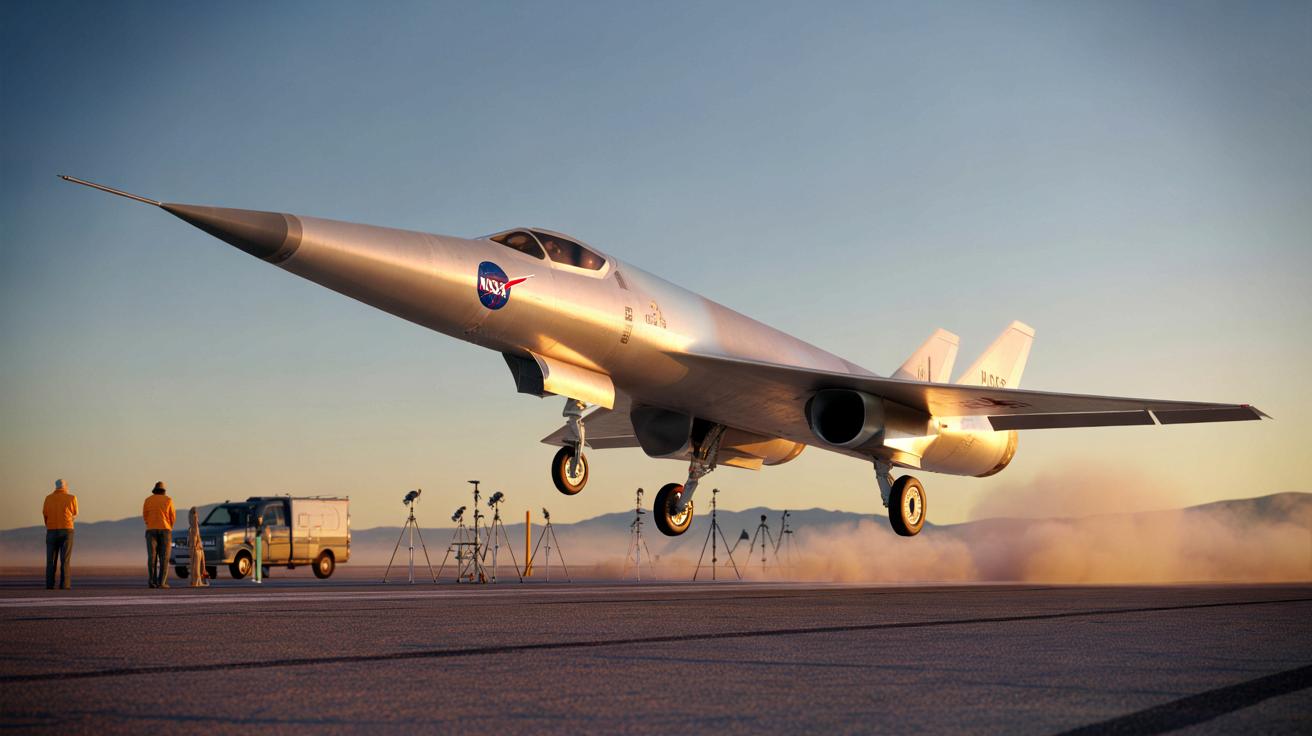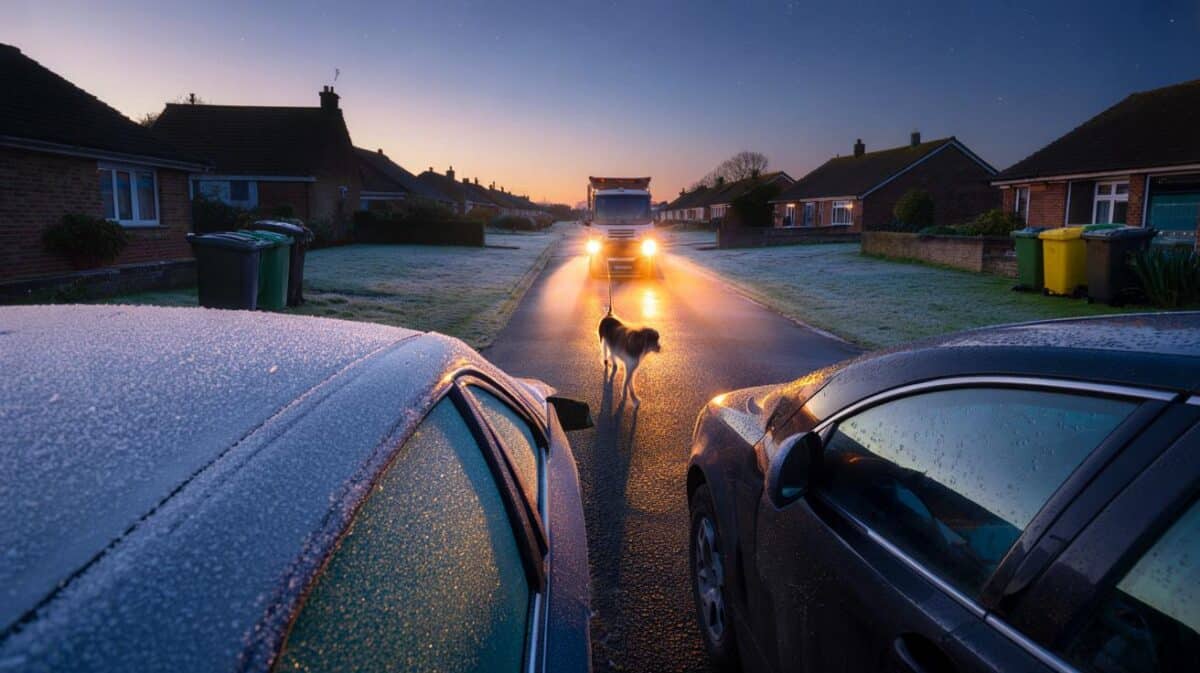Lockheed Martin’s X‑59 has completed its first mission, not with a thunderclap, but with a measured, engineerly calm that hints at a bigger upheaval: changing how the world hears speed.
It started so early the desert hadn’t made up its mind about the day. In the blue-grey before sunrise at Edwards, the X‑59 rolled out like an arrowhead come to life, long nose glinting, ground crew in orange vests blinking sleep from their eyes. You could feel that hush you only get around machines about to prove a point. The jet lifted, steadied, and carved a line across a sky that still felt private.
It was a short flight, but it felt like a curtain lifting. No drama. Just poise.
From silence to “thump”: a first mission that sounds like the future
The X‑59’s first mission was a test card written in pencil and flown in ink. Engineers wanted basic truths: does it track straight, talk cleanly to the ground, respond the way the simulators promised. The aircraft did the grown-up things new aircraft must do: taxi without fuss, rotate with intent, climb with restraint. Then it settled into a measured profile over the Mojave, ticking off points that let the team breathe again. The landing looked almost ordinary, which is exactly the kind of magic flight-test people pray for.
Here’s the standout detail: the aim is not speed alone, but the sound that speed makes. Concorde’s boom could hit 105–110 PLdB on the ground; the X‑59 is engineered to push that down near the 75 PLdB mark, a **“sonic thump”** more like a car door closing a street away than a window-rattling crack. On this first mission, crews focused on systems and handling rather than full-tilt acoustics, yet the range bristled with microphones and telemetry gear. The data trail now stretches from rivet to runway, a living map of what the aeroplane did, and just how politely it did it.
Why this matters comes down to a line in the law older than most of the people in the control room: the US ban on civil supersonic flight over land. Regulations answer to evidence, not PowerPoints. NASA’s Quiet Supersonic mission exists to collect that evidence well enough to be boring in a Congressional briefing—repeatable, peer‑reviewed, dull in the best way. This first sortie opens that pipeline. It proved the aircraft is controllable, the sensors are listening, and the team can fly again tomorrow. That’s the architecture of change.
What the first mission tells us—and how to read it like a pro
Think of a first mission as a shakedown with manners. Pilots fly conservative speeds and altitudes, expand the envelope in thumb‑widths, and keep contingency options close. Watch for three signals: did the aircraft meet the test points; did the post‑flight debrief sound like a checklist rather than a thriller; did NASA publish clean telemetry highlights within hours. Those are the tells that the aeroplane is doing what it says on the tin. *Boring is glorious in flight test.*
Common pitfalls? Expectation drift. People hear “supersonic” and imagine a sonic boom firework on day one. Not how this game works. Early missions are subsonic or near the barrier, with focus on handling qualities, cockpit visibility via the eXternal Vision System, and the choreography between Skunk Works and NASA Armstrong. Let’s be honest: nobody does this every day. Crews will pause between flights to strip every second of data, compare it to the models, and only then take the next step. We’ve all had that moment when patience feels like delay; in aerospace, patience is the safety net.
“This is how progress sounds: a soft thump, not a boom.”
- Look for PLdB numbers and how they’re measured, not just adjectives like “quiet”.
- Track where flights occur: Edwards test range first, community overflights later.
- Note the milestones: envelope expansion, first supersonic, initial acoustic validation, then community response trials.
- Separate manufacturer hype from NASA’s technical notes; both matter for different reasons.
- Bookmark what comes next: **community overflights** intended to inform regulators.
Beyond the first mission: what changes when speed stops shouting
The X‑59 sits at the crossroads of technology, policy, and culture. If an aircraft can slip past Mach 1 and leave nothing worse than a distant thud, large chunks of the map redraw themselves. Flight times tighten across continents. Regional airports dream bigger. Designers ask fresh questions about range, fuel, and route economics. There’s a catch, of course: one graceful mission does not rewrite rules. It invites a conversation with data on the table. That conversation is just beginning.
NASA’s long game is simple to say and hard to do: generate a body of evidence that regulators can trust, communities can live with, and industry can build upon. Today it’s a single aircraft crafting a narrow signature; tomorrow it could be a cluster of designs tuned for routes and markets we haven’t dared cost out in twenty years. Expect a procession of missions in the months ahead: expanding speed, evaluating shock‑shaping, and staging measured overflights above instrumented towns. The aim is a public that hears the sound and shrugs, then says yes.
There’s also a quieter revolution underway inside the cockpit. The X‑59’s knife‑long nose erases the pilot’s forward view at low altitude, so an augmented “window” stitches camera feeds and sensor overlays into a synthetic horizon. That system is not a party trick; it’s a necessity that may spill into broader aviation once it proves itself in heat and glare. **First mission completed** means the software survived the real sky and the human brain trusted it when wheels kissed concrete. That’s not a headline line item. It’s the sort of change you only notice when it becomes normal.
What to watch next, without losing the plot
Want a simple method to follow the programme without falling into the hype cycle? Track three threads: flight cadence, acoustic metrics, and community engagement. Cadence shows confidence; if sorties come in a steady rhythm, the team is clearing issues fast. Acoustic metrics show purpose; when NASA starts publishing ground‑recorded PLdB curves from controlled runs, you’ll know the “quiet” in quiet supersonic is moving from promise to proof. Community engagement shows consequence; town hall dates, survey methods, and where microphones get placed tell you this isn’t just a tech demo, it’s policy homework.
Another practical tip: separate risk from drama. A rejected take‑off or scrub looks loud on social, but in test programmes, a scrub is usually prudence doing its job. Don’t confuse a long gap between flights with trouble unless the team says so. Read the daily notes, not the comments. And when you see “envelope expansion,” picture an instructor letting out a kite string one arm‑length at a time, checking the wind each pull. You want that string long. You want those checks.
“Speed, reimagined, is only meaningful if people on the ground accept the way it sounds.”
- Follow NASA Armstrong updates for verified milestones and telemetry snippets.
- Watch Lockheed Martin’s Skunk Works feeds for build and maintenance insights.
- Learn the key acronyms: PLdB, EAB (envelope expansion), CVS/EVS (vision systems).
- Time zones matter; early morning flights are common for smooth air and empty ranges.
- If you live near the range, report any noise through the channels NASA provides, not via viral posts.
A milestone that invites more questions than it answers
The X‑59’s first mission is both a line crossed and a door opened. A flying hypothesis took off, came back, and handed engineers evidence instead of surprises. That is oddly moving. It suggests we might be done treating the sonic boom as a fact of physics and start treating it as a design variable. If the next flights confirm the numbers, the conversation shifts from “can we?” to “where and when do we want to?”
There will be debates over cost, climate, and who benefits. There should be. Aviation’s best leaps have always thrown big shadows. What feels different here is the humility in the approach: test, listen, ask, repeat. The aircraft didn’t roar its arrival; it negotiated it. That’s not just a sound. It’s a stance worth remembering—and sharing.
| Point clé | Détail | Intérêt pour le lecteur |
|---|---|---|
| X‑59’s first mission | Completed initial flight profile with systems and handling checks at Edwards | Signals real progress beyond renderings and press releases |
| Quiet supersonic goal | Targeting ~75 PLdB “sonic thump” versus Concorde‑era 105–110 PLdB | Explains why this could unlock overland supersonic routes |
| What’s next | Envelope expansion, acoustic validation, and community overflights feeding regulators | Shows how this could shape future travel times and rules |
FAQ :
- What exactly is the X‑59?A NASA–Lockheed Martin experimental jet designed to demonstrate “quiet” supersonic flight by shaping shockwaves into a gentler ground signature.
- Did the first mission go supersonic?No. Early sorties focus on basic aircraft behaviour and systems checks; controlled supersonic runs come later in the test envelope.
- What does “first mission completed” really mean?It means the aircraft flew a planned profile, hit key test points, returned safely, and produced data that matches pre‑flight models.
- When will community overflights happen?After envelope expansion and acoustic validation at the range, NASA plans measured overflights of selected communities to collect public response data.
- Will this change the ban on overland supersonic flight?Not automatically. NASA’s data will inform regulators; any rule change depends on evidence, public acceptance, and international alignment.







